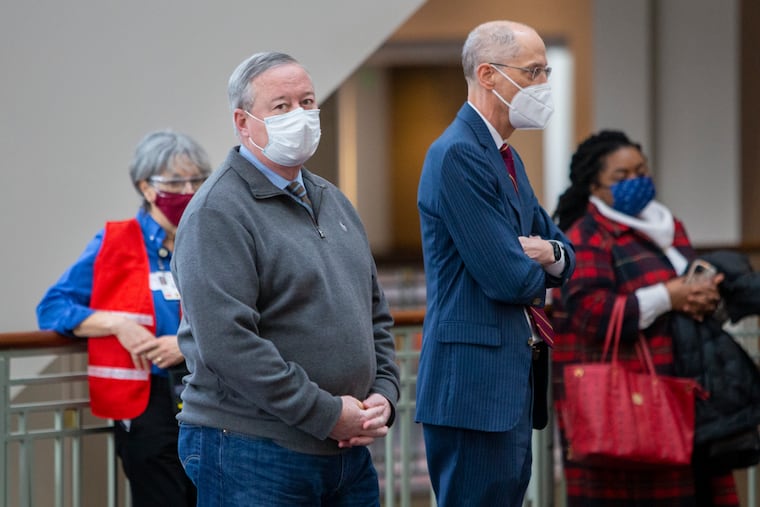How basic engineering concepts could help solve Philly vaccination problems | Opinion
Systems engineering creates predictable, testable outcomes to maximize efficiency. So let's apply it to the biggest problem facing Philadelphia today.

After 11 months, even with two vaccines available, a pair of pressing issues prevent a clear end to the COVID-19 pandemic: transparency and trust.
Engineers and scientists rely on systems and processes as a key foundation. Systems engineering creates predictable, testable outcomes to maximize efficiency. It is often used in health care, from improving patient outcomes to customer satisfaction. To be sure, vaccines don’t get into waiting arms by themselves, but by a complex, interrelated network of vaccine administration sites, providers, and an informed general public willing to be vaccinated.
As cities like Philadelphia continue to face false starts and backlash from the current vaccine rollout — including Philly’s latest vaccine debacle, severing ties with Philly Fighting COVID — it can be instructive to step back and reexamine the system in place with an eye toward rebuilding trust and creating transparency.
What steps can cities like Philadelphia take right now to mitigate as many issues as possible and maximize the number of people who get vaccinated?
Let’s start with a baseline of facts. Even with clearer federal guidance, we do not know for certain how many doses we will be getting, when they will come, and where they will go. We do not know how many of the different brands we will get; therefore, we do not know the exact storage requirements. We do not know what percent of the population will willingly receive a vaccine, and we don’t know how many of those will return for their second dose.
We do have some registration information that can give us a glimpse of the possible demand; however, since there are multiple sites on which people can register, this information is distorted.
From a supply chain perspective, this is a last-mile effort where in short: the city is dealing with imperfect and missing information. It is akin to getting your groceries from Instacart, except only telling your shopper you want “soup” while expecting them to bring clam chowder. With imperfect information comes confusion and misinformation.
It’s understandable that Philly residents may be feeling mixed up about vaccinations, but it’s up to the city to solve this problem — quickly. As time is of the essence, from my perspective as a systems engineer, there are three immediate efforts that the city should enact to improve trust and create transparency around vaccine distribution:
Human systems integration
Real-time monitoring
Public feedback
Human systems integration involves incorporating the human element into the process. Not everything can be done automatically, especially when it comes to building trust around a medical procedure. Sometimes humans need to talk to other humans. For vaccinations in a city as diverse as Philadelphia, this means working with communities and organizations like the highly trusted Black Doctors COVID Consortium to broadcast information and build trust on vaccine efficacy and safety. Not only would this help to achieve an equitable distribution of the vaccine, but also help the city repair the bonds of trust with neighborhoods, particularly Black neighborhoods where vaccine hesitancy is known to be high.
» READ MORE: Philly’s bungled COVID-19 vaccine rollout erodes trust at a time when it’s needed the most | Jenice Armstrong
Real-time systems monitoring can be used to capture demand and supply information at administration sites. This will allow for dynamically adjusted dosage distribution, more efficient scheduling of providers, fewer bottlenecks, and fewer wasted vaccines. In other words, we can not only identify supply and demand problems but solve them before they interfere with distribution, getting vaccines where they need to be the most. Better data means better outcomes.
Public dissemination of the supply and demand data — how many vaccines we have and how many people still need it — with realistic timelines, will ease some frustration and confusion. The city should consider circulating this information through various formats geared toward the target population — for example, on social media, or a trusted government website — to ensure everyone has the opportunity to receive the information, be informed, and therefore increase their likelihood of returning for a second shot.
Systems engineering is a comprehensive, integrated approach to tackling a complex problem. While we cannot go back and start from scratch, we can take best practices from what we do know how to do well and apply them as best we can under the given circumstances. A holistic yet relatively simple approach can yield great dividends in getting enough of the population vaccinated safely and efficiently.
Julie Drzymalski is a professor of instruction and director of the industrial and systems engineering program at Temple University College of Engineering.